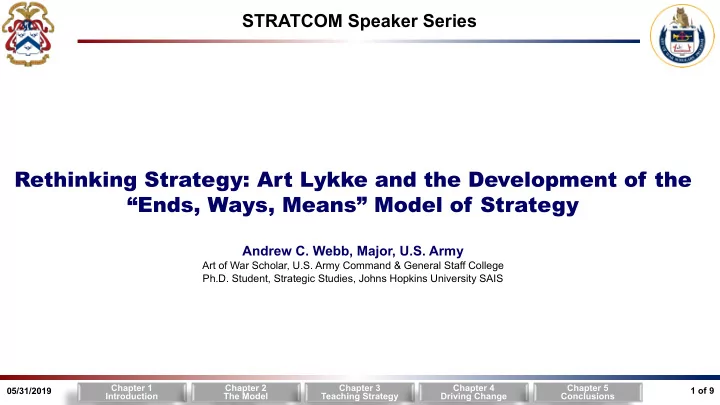

STRATCOM Speaker Series Rethinking Strategy: Art Lykke and the Development of the “Ends, Ways, Means” Model of Strategy Andrew C. Webb, Major, U.S. Army Art of War Scholar, U.S. Army Command & General Staff College Ph.D. Student, Strategic Studies, Johns Hopkins University SAIS Chapter 1 Chapter 2 Chapter 3 Chapter 4 Chapter 5 05/31/2019 1 of 9 Introduction The Model Teaching Strategy Driving Change Conclusions
Key Takeaways • The “Ends, Ways, Means” model of strategy is the product of a single Professor at the U.S. Army War College, Colonel Arthur F. Lykke, Jr. • The “Ends, Ways, Means” model did not gain immediate acceptance due to concerns over Lykke’s expertise and the model’s assumptions, logic, and evidence. • The model eventually emerged as the dominate framework in the U.S. Army due to Lykke’s longevity at the U.S. Army War College, his editorial control of key course texts, and circumstances unique to the 1980s. • The “Ends, Ways, Means” model is inadequate for most strategy making today. 05/31/2019 2 of 9
Research Questions Research Questions: 1. Who is Arthur F. Lykke, Jr. and why did he develop the “Ends, Ways, Means” model of strategy? 2. How did Lykke articulate the model and how did his contemporaries react to his new model? 3. How did Lykke’s position at the U.S. Army War College contribute to the development and eventual acceptance of the “Ends, Ways, Means” model? 4. What external influences in the global security environment, changes within the U.S. Army, and U.S. civilian policymaker policy guidance influenced the acceptance of Lykke’s “Ends, Ways, Means” model during the 1980s? 5. Is “Ends, Ways, Means” a useful model for the strategy-making needs of the U.S. Army and U.S. military today? Chapter 1 Chapter 2 Chapter 3 Chapter 4 Chapter 5 05/31/2019 3 of 9 Introduction The Model Teaching Strategy Driving Change Conclusions
Chapter 1: Introduction • Purpose • Research Method • Assumptions • Definitions • Scope • Limitations • Significance Chapter 1 Chapter 2 Chapter 3 Chapter 4 Chapter 5 05/31/2019 4 of 9 Introduction The Model Teaching Strategy Driving Change Conclusions
Chapter 2: Ends, Ways, Means: The Development of the Lykke Model • Who is Arthur F. Lykke, Jr.? • Lykke’s Senate Testimony • Assumptions, Logic, Evidence • Reaction from fellow panelists • Lykke’s silence during the discussion • “Defining Military Strategy” • Key Conclusions Image 1: The Strategy Stool Image 2: Military Review, May 1989 Chapter 1 Chapter 2 Chapter 3 Chapter 4 Chapter 5 05/31/2019 5 of 9 Introduction The Model Teaching Strategy Driving Change Conclusions
Chapter 3: Teaching Strategy at Carlisle in the 1980s • The 1982 Edition of Military Strategy • Wide range of perspectives, diverse authors, contradictory viewpoints • Lykke’s model as a model, not the model • Breadth and depth of the dimensions of strategy • The 1989 Edition of Military Strategy • Narrow Anglo-American, military perspective on strategy • Prominence of Lykke and “Ends, Ways, Means” • Reduction in the dimensions of strategy Chapter 1 Chapter 2 Chapter 3 Chapter 4 Chapter 5 05/31/2019 6 of 9 Introduction The Model Teaching Strategy Driving Change Conclusions
Chapter 4: Driving Change: From a Hollow Army to Desert Storm • The Global Security Environment of the 1980s • The Middle East • Tensions with the Soviet Union • The U.S. Army of the Era • The Shadow of Vietnam • The transformation of the Army, especially doctrine • The Weinberger Doctrine Chapter 1 Chapter 2 Chapter 3 Chapter 4 Chapter 5 05/31/2019 7 of 9 Introduction The Model Teaching Strategy Driving Change Conclusions
Chapter 5: Conclusions • Lykke’s “Ends, Ways, Means” model of strategy emerged as the dominate strategy model within the U.S. Army in the 1980s despite three major weaknesses: 1. Separation of military strategy from national strategy 2. Problems of formulation a. Two different formulas, neither logical b. Circular definition 3. Questionable use of quotations from strategists • So what? • Importance of doctrine • A different world Chapter 1 Chapter 2 Chapter 3 Chapter 4 Chapter 5 05/31/2019 8 of 9 Introduction The Model Teaching Strategy Driving Change Conclusions
Questions and Discussion 05/31/2019 9 of 9
Recommend
More recommend